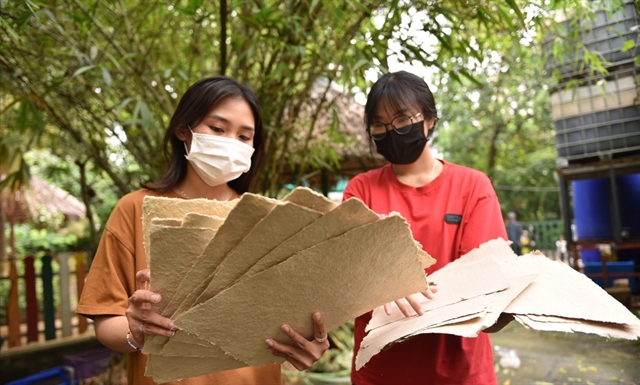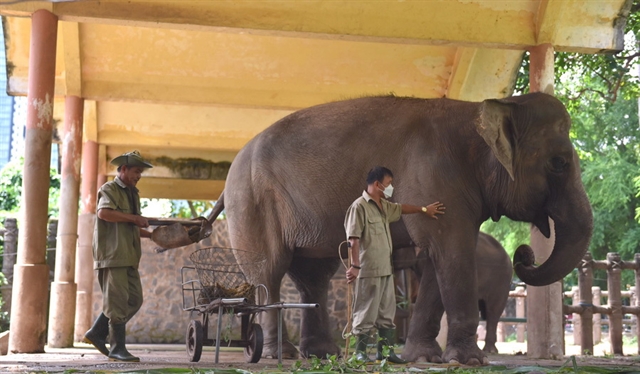 Society
Society

 |
Two students from the HCM City University of Technology (HUTECH) show their paper sheets made from elephant dung at the Sài Gòn Zoo and Botanical Garden in HCM City. — Photo tuoitrenews.vn
HCM CITY — The Sài Gòn Zoo and Botanical Garden’s staff and a group of students at the HCM City University of Technology (HUTECH) in HCM City are making eco-friendly paper from elephant dung every weekend.
Mai Khắc Trung Trực, director of the Sài Gòn Zoo, said transforming elephant dung into paper has been done in many countries, but it is a new idea in Việt Nam.
In the past, the dung was discarded or used as manure. Now, it gets recycled into paper.
Five adult elephants at the zoo have not only served visitors but also helped produce eco-friendly paper.
“The elephants eat mostly grass, sugar cane and vegetables, so their dung is not too smelly, has a lot of fiber and can be used to make paper,” he said.
The zoo has been recycling elephant dung since February, and the first elephant dung paper was produced in April.
“The recycling will help raise awareness about wildlife protection and teach children to save natural resources and protect the environment,” he said.
 |
The Sài Gòn Zoo and Botanical Gardens’s staff collect elephant dung at the animal’s enclosure. — Photo tuoitrenews.vn
The process of paper-making is done manually without any industrial chemicals.
The zoo’s employees collect around 800kg of dung from the elephants everyday in their enclosure, but only five kilos are being used to make paper every weekend.
The collected dung is washed at least seven times to remove impurities, leaving only the fiber left for recycling. The fiber is boiled at 200 degrees Celsius for two hours to kill bacteria and remove odor.
"This is still experimental and no machinery is used, so we only make several dozen paper sheets at a time," Trực said.
The boiled fibres are then dried under the sun. The dried fibres are pureed into powder, and then mixed with water, tapioca starch and some paper pulp.
The mixture is finally poured into A3 and A4 paper-size molds and dried for another eight hours to get the final product.
 |
Foreign children draw on paper sheets made from elephant dung at the Le Petit Musee Gallery in HCM City’s Thủ Đức City. — Photo courtesy of Sài Gòn Zoo
Huỳnh Lê Như Ngọc, a student at HUTECH majoring in animal husbandry and member of the group recycling elephant dung into paper, said one kilogram of elephant dung yields 400 grams of fiber on average, and is used to produce about 30 paper sheets with the same thickness.
“The handmade paper has a light brown colour because no chemicals are involved. They are slightly rough to the touch, but quite tough and not easily torn,” she said.
The paper sheets became wet and moldy under certain weather conditions. The elephants also eat different kinds of food, meaning their dung is of varying quality as well, she said.
“Our product is much better now and we will continue to improve the quality of paper in the near future, hoping that the product will spread a positive message of environmental protection to the community," she said.
The paper sheets are now given to children at some educational institutions to paint on, make cards and other items.
"We hope when the quality of our paper improves, it can be used for other purposes," she said.
Some schools have placed orders for the paper to teach their students about environmental protection. In the future, they will experiment with making paper from giraffe or hippo dung, Trực said.
 |
Some kids visit and experience making paper from elephant dung at the Sài Gòn Zoo and Botanical Garden in HCM City. — Photo tienphong.vn
The zoo has also opened a traveling zoo education class offering kids experiences on making paper from elephant dung, he said.
Located on Nguyễn Bỉnh Khiêm Street in District 1, the Sài Gòn Zoo is one of the world's oldest zoos and the country's largest zoo and botanical garden.
It is home to thousands of plant and animal species, both endemic and foreign. — VNS




